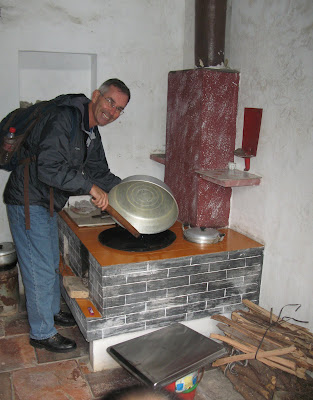
A monk called Frank. It's his "habit" name (nickname). He tends to be frank about what he says. Three years as a novice he still misses singing a bit but is devoted to becomming a monk when he turns twenty.
Unlike Bangkok, English is not spoken much outside the tourist industry in Chiang Mai. There is however a rather popular Wat complex within the old city walls that houses a University where English is taught to novices. At Wat Chedi Luang, not only is English taught, but it's use is encouraged and promoted as a way to teach foriegners about life as a monk and Buddism. It's not unusal to have a young novice (someone studying to become a monk) approach you and strike up a conversation in English.
 Thailand is over 80% Buddhist but nowhere in the country is Buddhism more evident than here in Chiang Mai.
Thailand is over 80% Buddhist but nowhere in the country is Buddhism more evident than here in Chiang Mai.Wat Phra Singh is the main Wat in the city of Chiang Mai and it's well worth a closer look when visiting the city.
Although Wat Phra Singh is not an unusual name for a temple, Wat means temple, Phra is used to refer to Buddha or a revered Monk, and Singh is a mythical lion-like creature, Chiang Mai's Wat Phra Singh is the most famous one in all of Thailand.
The temple contains some of the most beautiful examples of Lanna Art dating back to the Wat's orgin in 1345. A replica of the "lion style" Phra Singh Buddha sits in the Viharn Lai Kham (above left). The original Phra Sing Buddha is now housed in the Chiang Mai National Museum.
During the height of the Songkran Festival in April, the Buddha is mounted on a Royal Carriage and paraded through the streets for the people to pay homage in the traditional way.
 We arrived in Chiang Mai on the last day of November and upon visiting Wat Phra Singh we noticed that a huge monument of some sort was being erected on the main square of the Wat complex. We knew it was a temporary structure based of the materials used.
We arrived in Chiang Mai on the last day of November and upon visiting Wat Phra Singh we noticed that a huge monument of some sort was being erected on the main square of the Wat complex. We knew it was a temporary structure based of the materials used.As it turned out, it was a cremation vehicle for the former Provincial Head of Chiang Mai Monks who had passed away recently. It was commissioned to be built at the price of 500,000 baht ($15,000) and is to represent a "funeral playground".

 After four days of construction it was finished and fully operational. It had the tail of a serpent, the body of a bird, and the head of an elephant that included blinking eyes, a rolling trunk, flapping ears, and a swivel head, all rising some 60 feet off the ground.
After four days of construction it was finished and fully operational. It had the tail of a serpent, the body of a bird, and the head of an elephant that included blinking eyes, a rolling trunk, flapping ears, and a swivel head, all rising some 60 feet off the ground.




 Here, a contingent of monks and assorted Buddhists from the U.S. are viewed by a senior monk.
Here, a contingent of monks and assorted Buddhists from the U.S. are viewed by a senior monk.

He was referred to as the "President of all Monks in Thailand" by a couple of young novices who chose to enlighten us on the proceedings. Monks from several countries attended the nightly rituals, with interpreters on hand to explain what was going on.

 Pictured here are two novices that actually spoke pretty good English. The one on the left will become a monk next year after six years studying as a novice. The one on the right is named Moe and has a passion for boxing of all things. He kept naming boxer after boxer asking if I was familiar with each and every one of them. I of course was not.
Pictured here are two novices that actually spoke pretty good English. The one on the left will become a monk next year after six years studying as a novice. The one on the right is named Moe and has a passion for boxing of all things. He kept naming boxer after boxer asking if I was familiar with each and every one of them. I of course was not.Boys as young as twelve are indoctrinated as novices but becoming a monk does not come easy. Years of studying and a realizations of one's path is necessary before a novice can become a monk at the age of twenty.
The on the night of December 20, after five full days of ceremonies, the entire structure was burned to the ground.
.jpg)


























.JPG)

.JPG)
.JPG)
.JPG)
.jpg)
.JPG)
.JPG)
.JPG)

.JPG)
.JPG)
.jpg)
.JPG)
.JPG)
.JPG)
.jpg)
.jpg)
.jpg)
.jpg)
.jpg)
.jpg)